By the power of editing, a film can move from place to place or time to time instantly. Establishing shots tell the audience what they are seeing and when. Let’s see how they are used in Tarantula, a creature feature from 1955. This is a long post with many images.
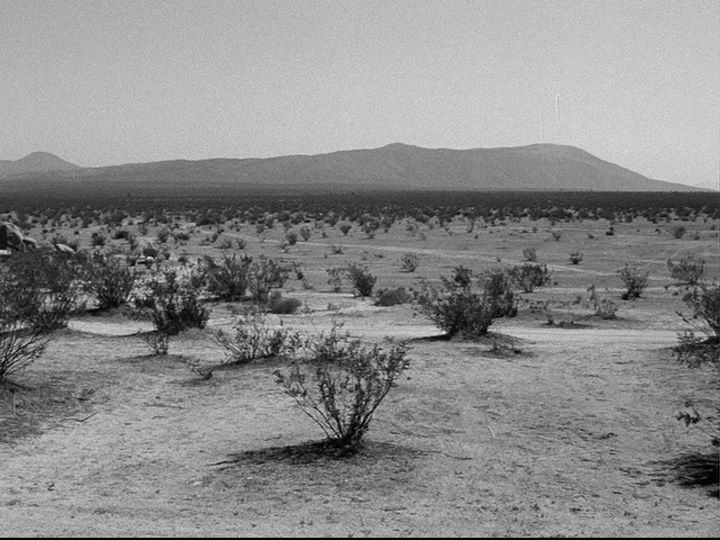
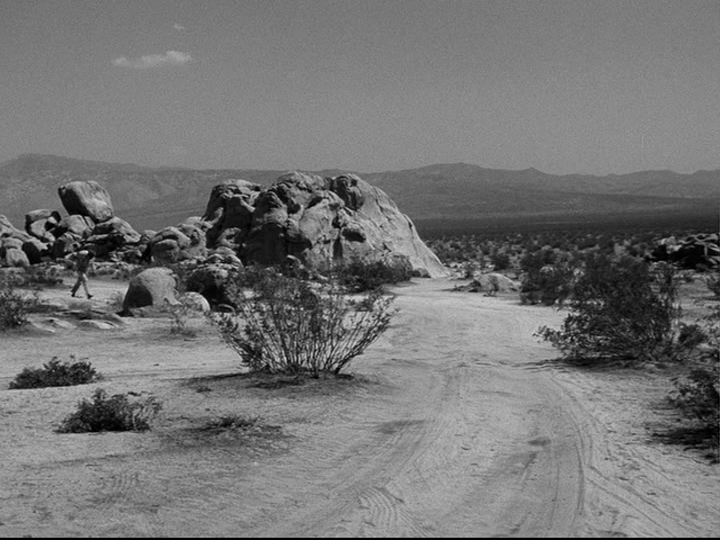

1. A wide shot, panning right to left across the desert until revealing a man staggering in the distance. It looks like the Southwestern United States, far from human settlement. That man is unhealthy, and there’s no help nearby.
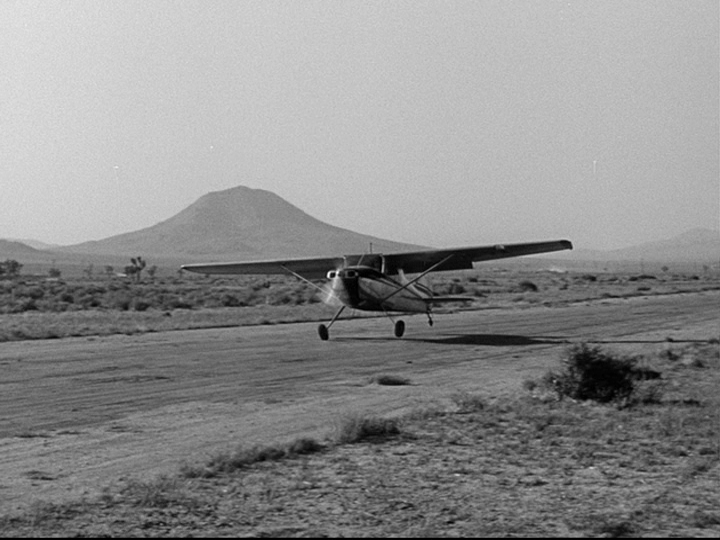
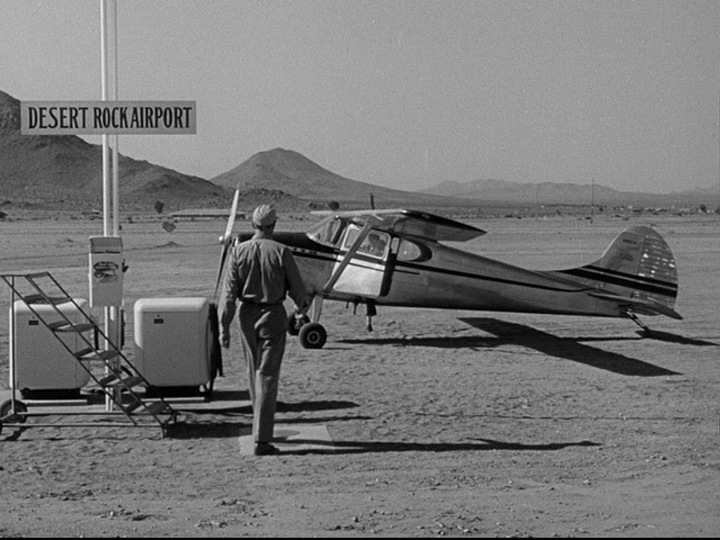
2. Cross-fade to an airplane landing on a desert airstrip. This is probably in the same area as the staggering man, since they are both in the desert. Not much to go on, but the second shot reveals more context. Crossfade to a sign that reads “Desert Rock Airport” That’s our exact location.
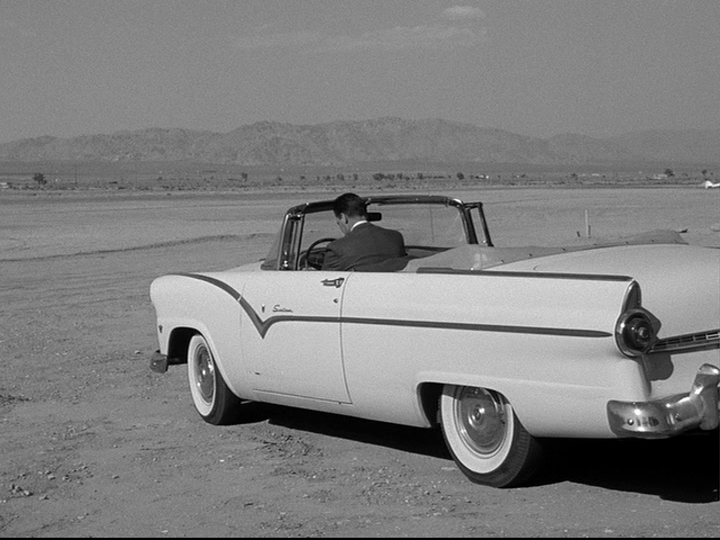
2a. The last shot of this scene is Doc (the pilot who just landed) driving away in a white convertible.
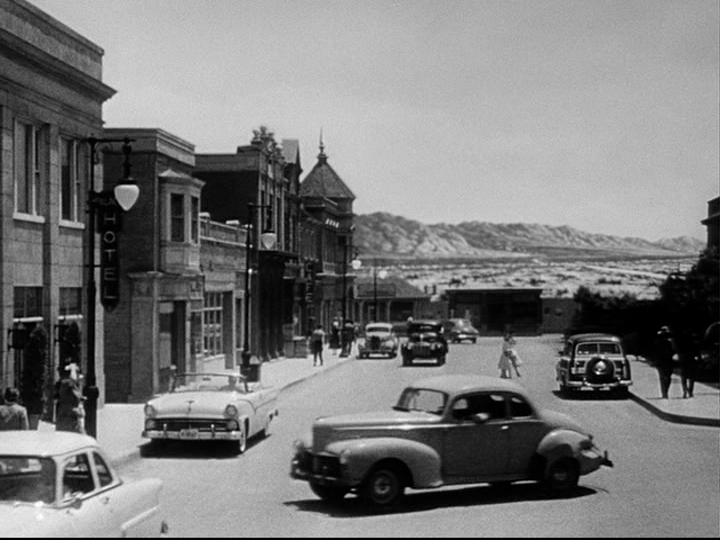
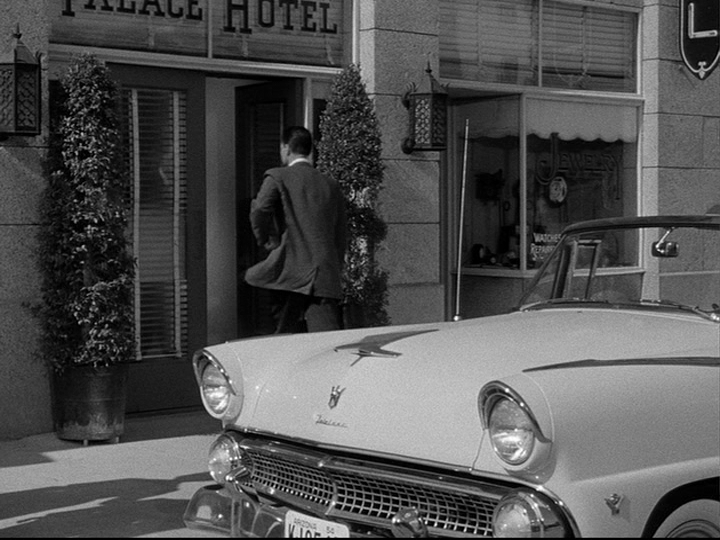
3. Crossfade to a white convertible parking next to a building with a sign that reads “HOTEL” The audience recognizes Doc’s car. For more context, the next shot shows Doc going inside, and mostly shows a sign reading “PALACE HOTEL”

4. The last shot of this scene is Doc picking up the phone after the hotel manager says he has the Sheriff on the line
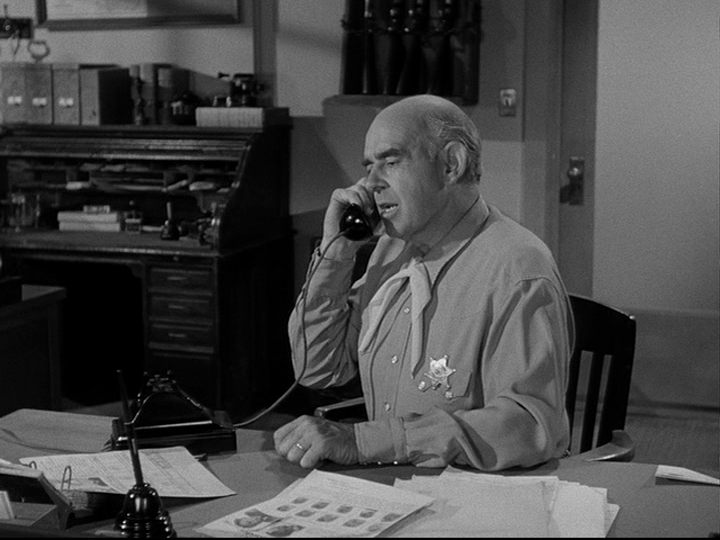
5. Cut to a man we’ve never seen in a room we’ve never seen. Surely this is the man on the other end of the phone call. He has a Sheriff’s star pinned to his chest, so he’s the Sheriff. The room has desks, mugshots, fingerprints, and shotguns, so it’s probably the Sheriff’s office.

6. Cut to Doc right where we saw him last. He’s still talking on the phone with Sheriff Jim. If you don’t remember this character’s name or occupation, his name is on the door: “MATTHEW HASTINGS M.D.” and the room, with a jar of cotton swabs and a diploma on the wall, looks like a doctor’s office.

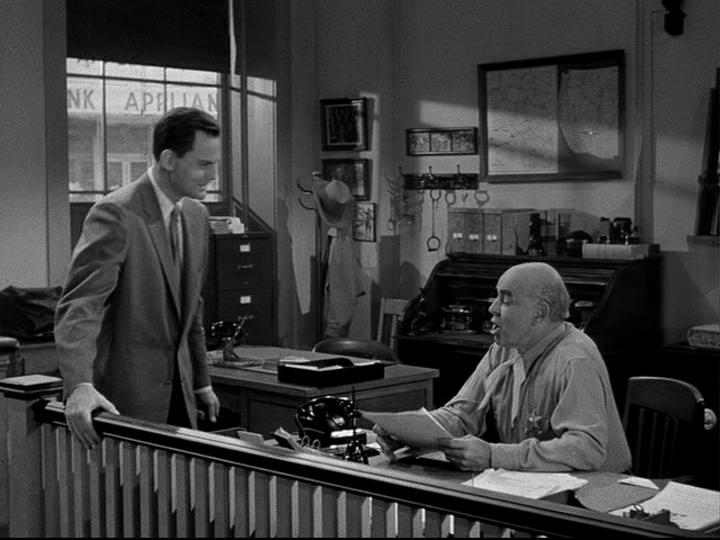
7. Cross-fade to Doc entering a building. The camera pans to the right as he walks past the window that reads “Desert Rock County Sheriff’s Office” and approaches the Sheriff we saw earlier, sitting at the same desk. Clearly, Doc has come to visit Sheriff Jim.
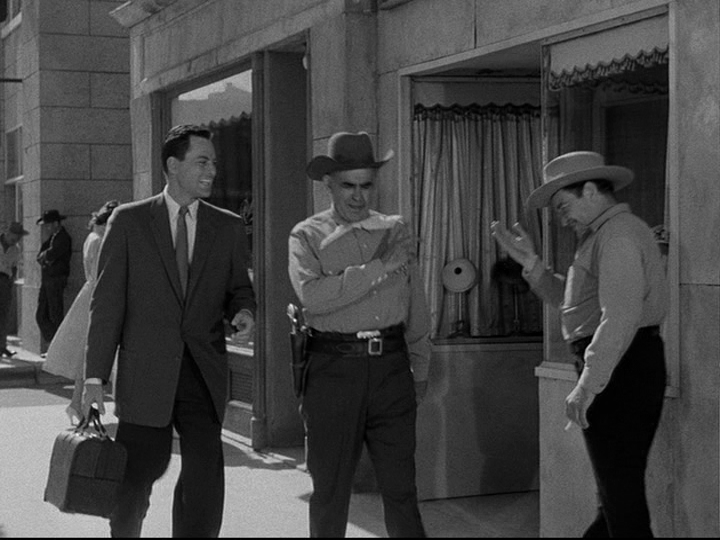

8. Cross-fade to Doc and Sheriff walking down the street to a shop labeled “B.E. Russell Funeral Parlor” They said they were going to see the undertaker to look at a body, and that’s what they are doing.
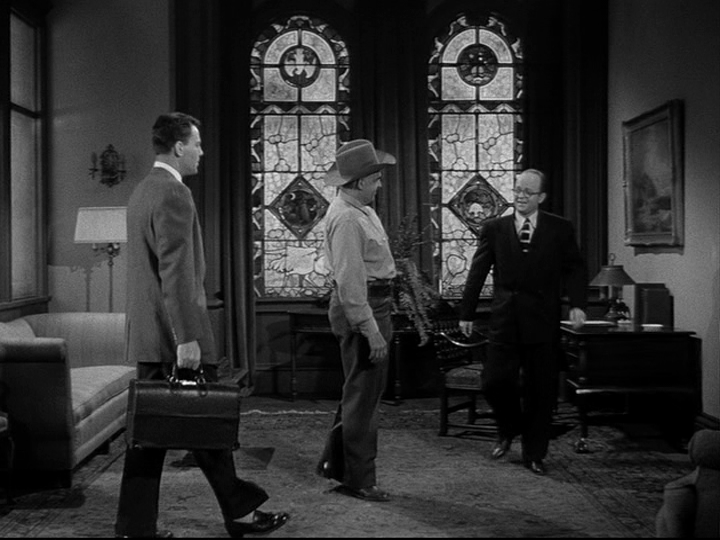
8a. In the next shot, Doc & Sheriff enter the funeral parlor’s lobby, which has distinctive large stained-glass windows. This will be important later.

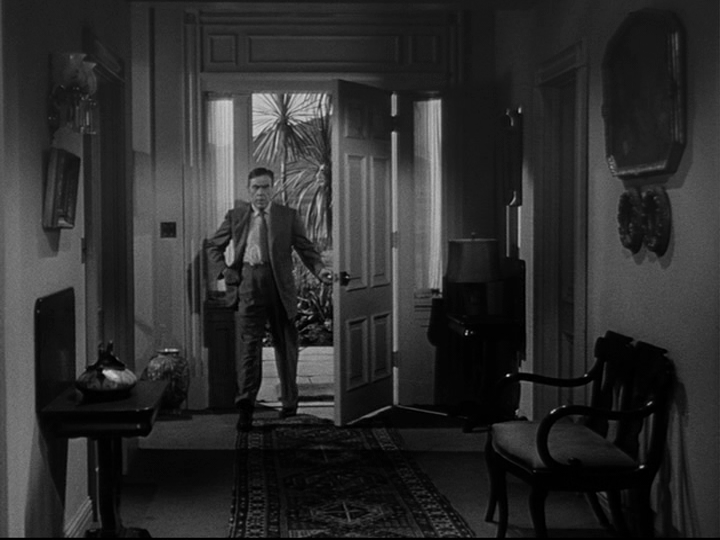
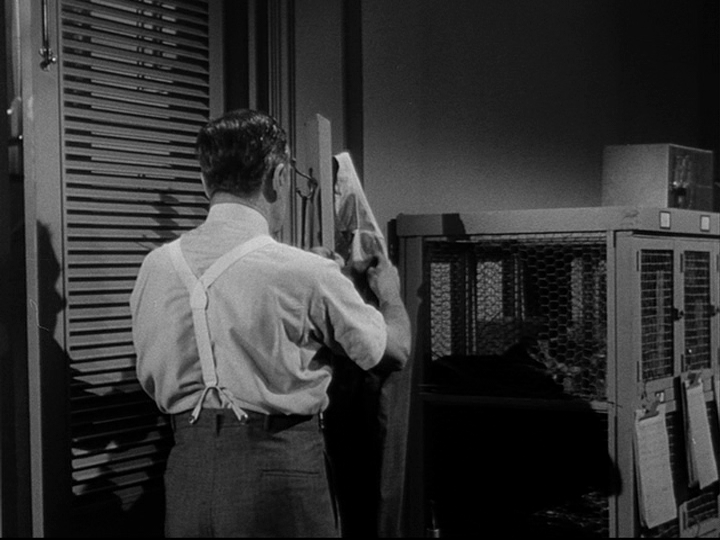
9. Cross-fade to a black sedan arriving at an isolated two-story building. Where is this, and who is arriving? Cross-fade to an interior and Professor Deemer walks in. The camera pans as he walks down a hall to room with cages, and switches his jacket for a lab coat. This must be Professor Deemer’s house, which also contains his lab.
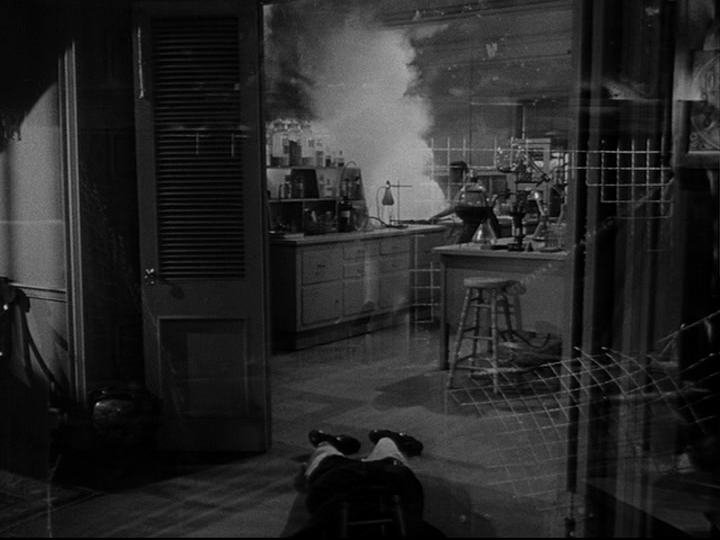
9a. The last shot of this scene shows Prof. Deemer battling a fire in his lab.
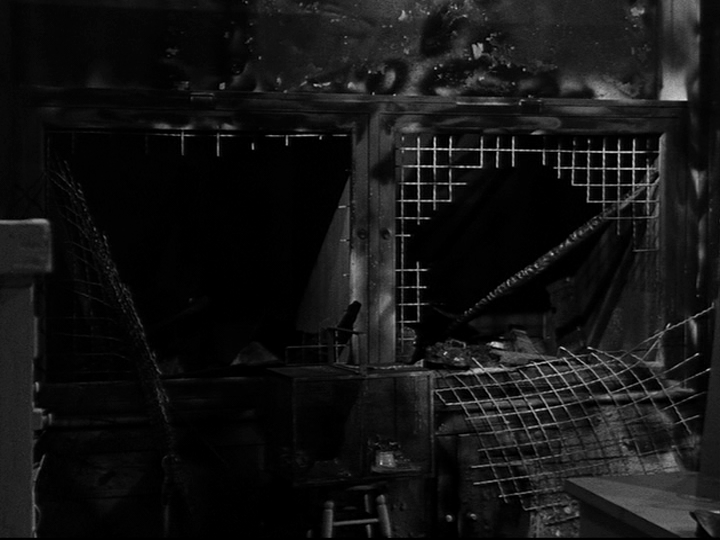
10. Cross-fade to scorched and broken cages. This is still Prof. Deemer’s lab, but the fire is gone, so we’ve moved in time to after the fire was extinguished.
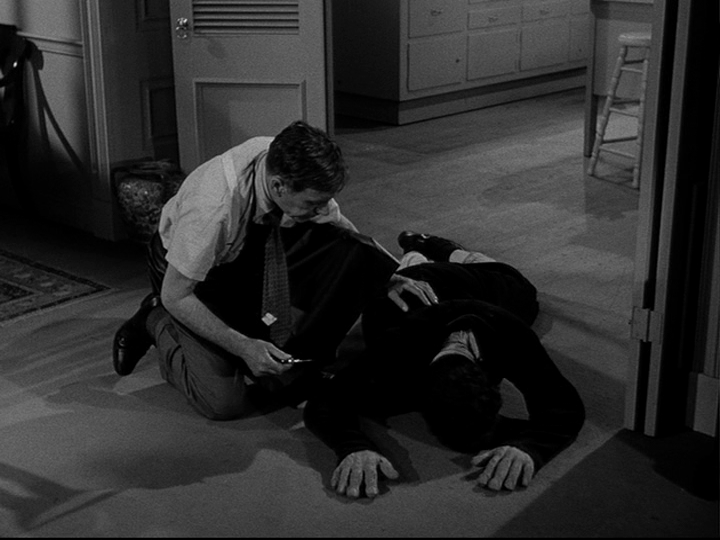
10a. The last shot of this scene shows Prof. Deemer examining the body of his former assistant.

11. Cross-fade to Prof. Deemer (recognizable by his white lab coat) filling in a hole out in the desert. Surely he buried the body of the assistant. Instead of a graveyard and a funeral, he buried the body out in the desert (there’s plenty of empty space around his house) He’s hiding the body.


12. Fade to black, then fade to Doc arriving (in his white convertible) at the Sheriff’s Office (with the sign in the window) It’s daylight, so the night has passed.
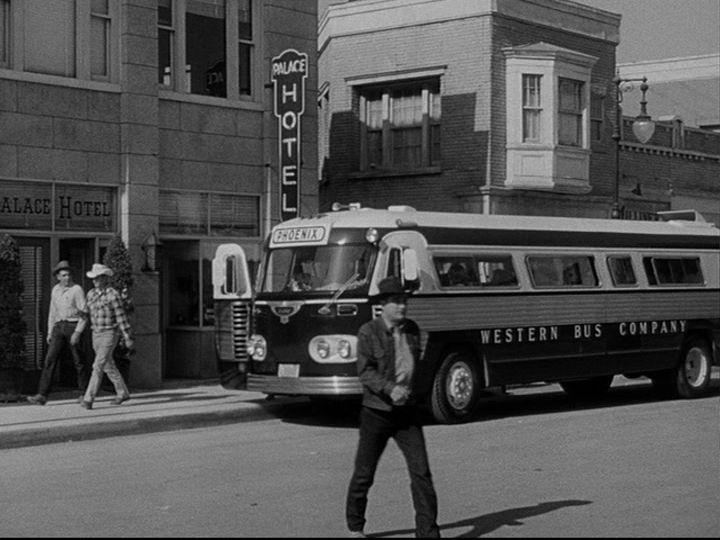
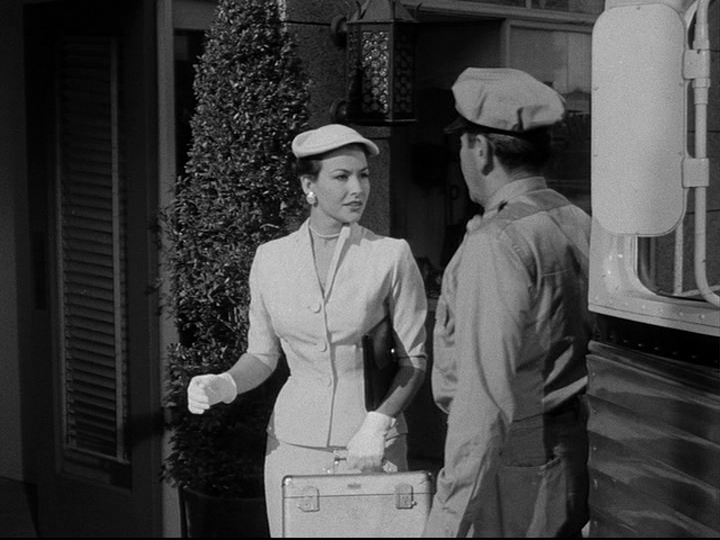
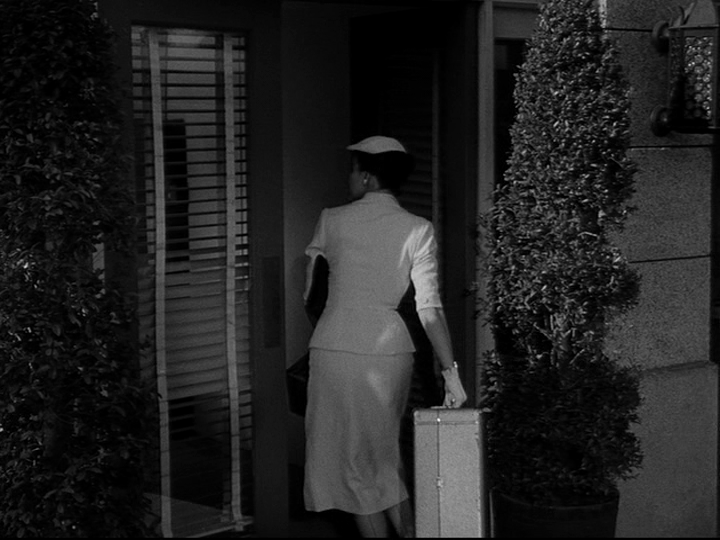
13. Cross-fade and pan left as a bus stops at the Palace Hotel (marked by a neon sign) In the next shot, a beautiful woman (the first woman we’ve seen!) emerges, asks for directions, and enters the hotel.


14. Cross-fade and pan left to follow the white convertible. That’s Doc’s car, so Doc is probably driving. Steve’s distinctive hat is visible, so Steve is riding along.

15. Cross-fade to the white convertible arriving at Deemer’s house. Deemer’s black sedan is gone, and a woodie wagon we haven’t seen before is parked out front. Doc has taken Steve to Deemer’s place, just like they arranged.

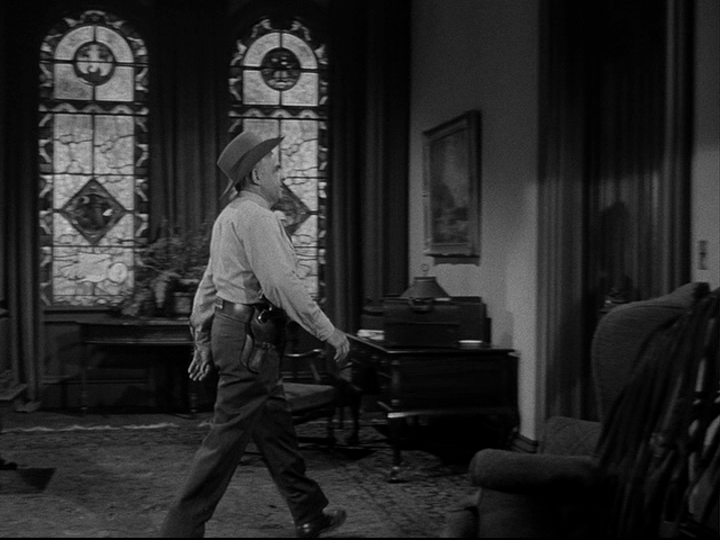
16. Cross-fade and pan right as Sheriff walks into a room. The scene does not start with an exterior shot, and no sign marks the location, but those distinctive windows were in Scene 7 at the funeral parlor. Sheriff has gone to the funeral parlor.
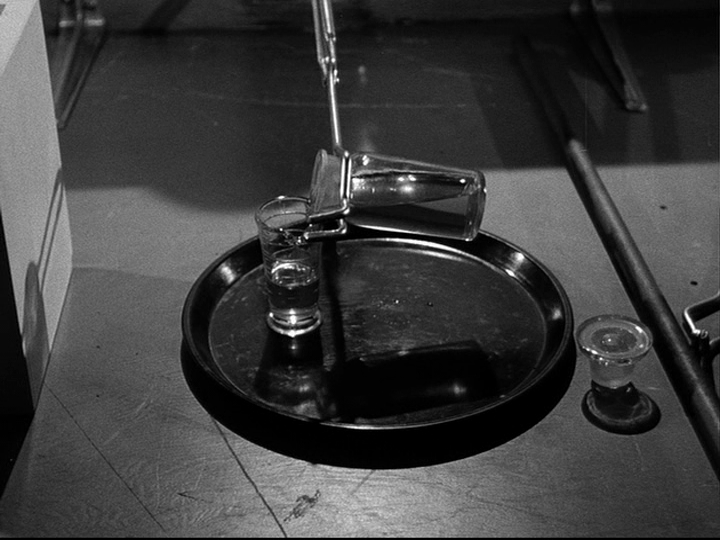
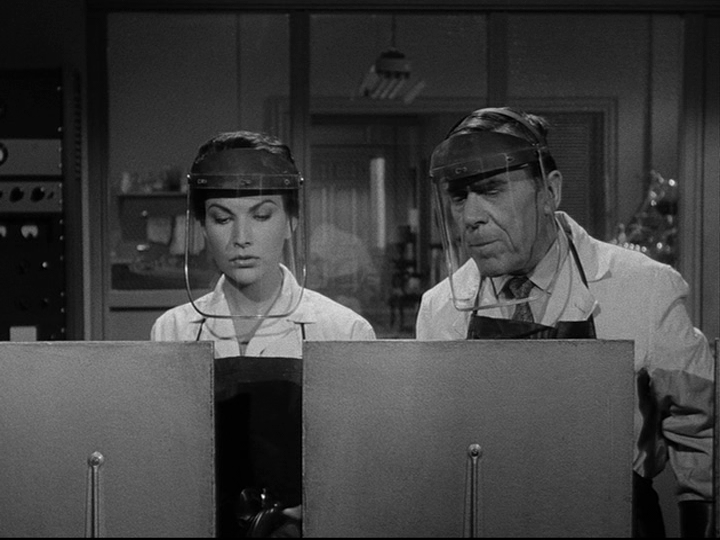
17. Cross-fade, pan up and zoom out a bit from some vials of chemicals, to Steve and Deemer wearing protective gear. An unusual transition! Instead of seeing a location and then seeing an action, we see the action first, then reveal the location (Deemer’s lab) and the characters.
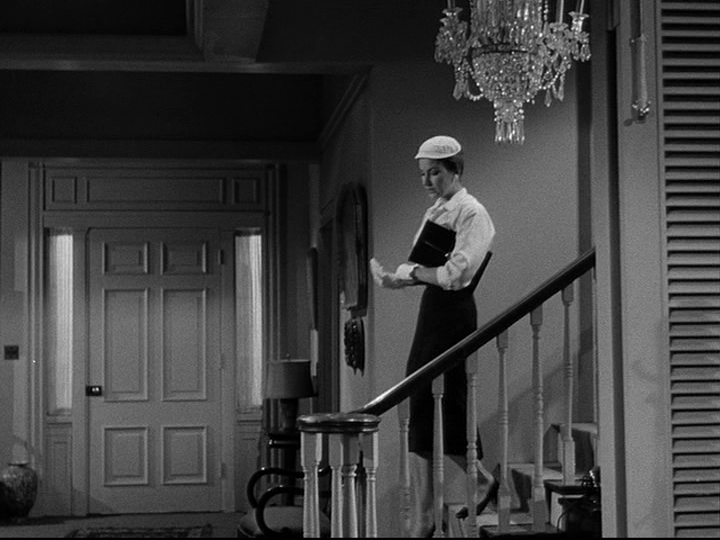
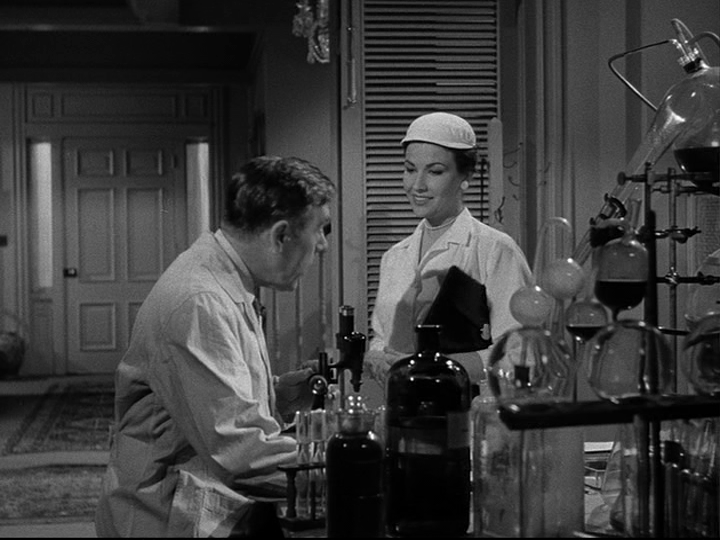
18. Cross-fade to Steve walking down stairs with white stair rods. If those stairs aren’t familiar, the camera dollies back to reveal Deemer working in the lab. That’s the entrance to Deemer’s house, and Steve was upstairs in the house. This is a transition through time more than space. Steve must have gone upstairs and changed in between scenes.
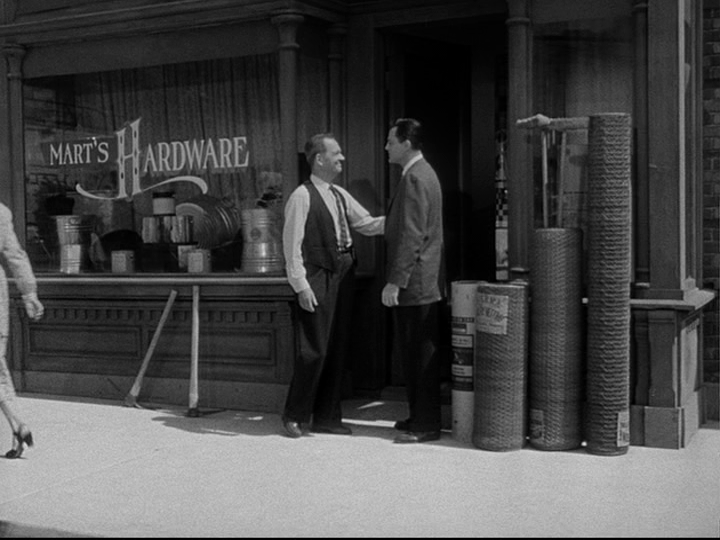
19. Cross-fade to Doc and an unfamliar man coming out of a shop labeled “Mart’s Hardware” That man must be Mart, and this must be a shop in Desert Rock, because there’s no other town nearby.
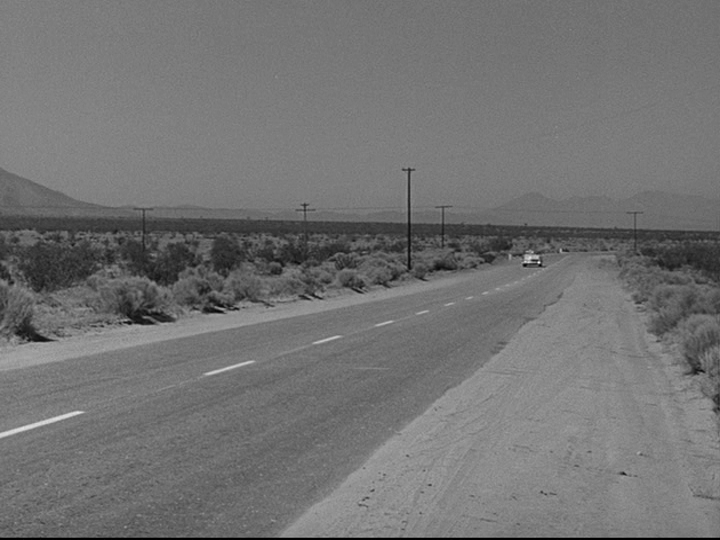
20. Cross-fade to the white convertible driving left on the desert road. Doc is driving Steve out to Deemer’s place again.
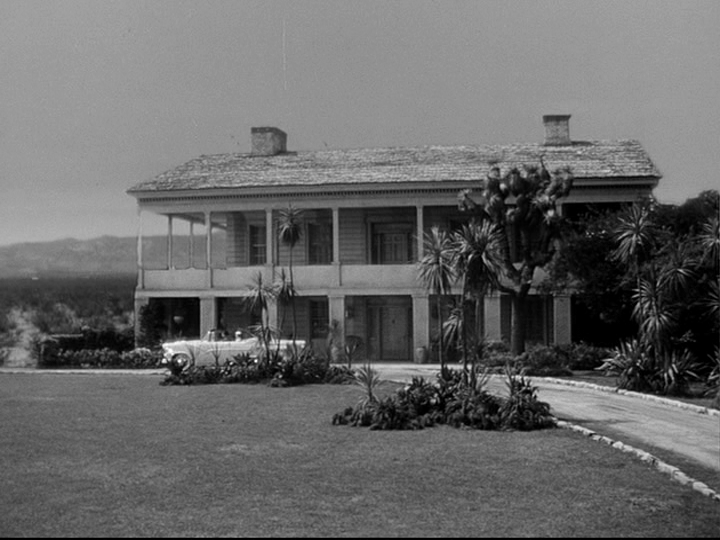
21. Cross-fade to the white convertible at the two-storey building. Doc & Steve arrive at Deemer’s house.
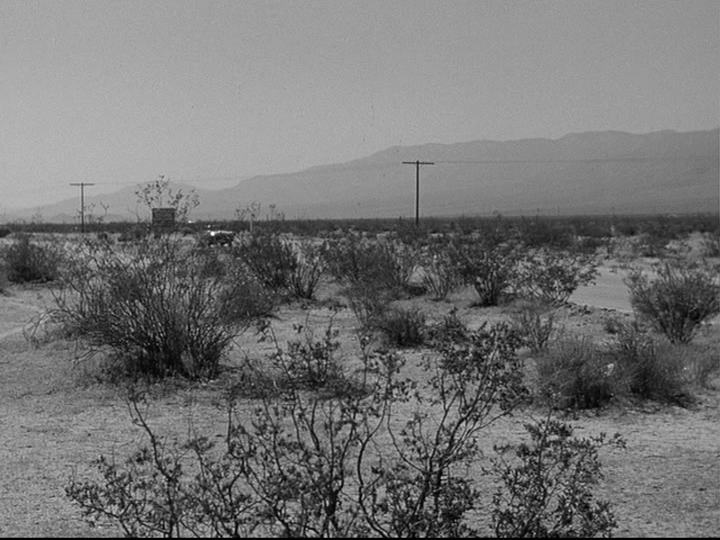
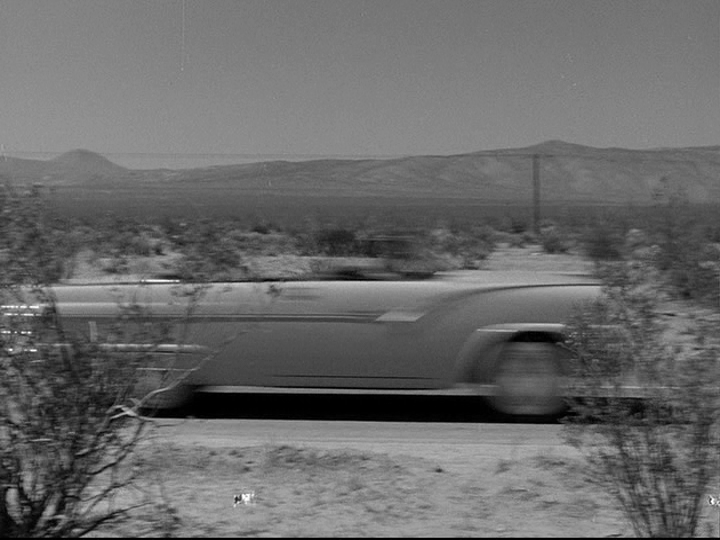
22. Cross-fade and pan right with the white convertible. Doc is driving away from Deemer’s place.

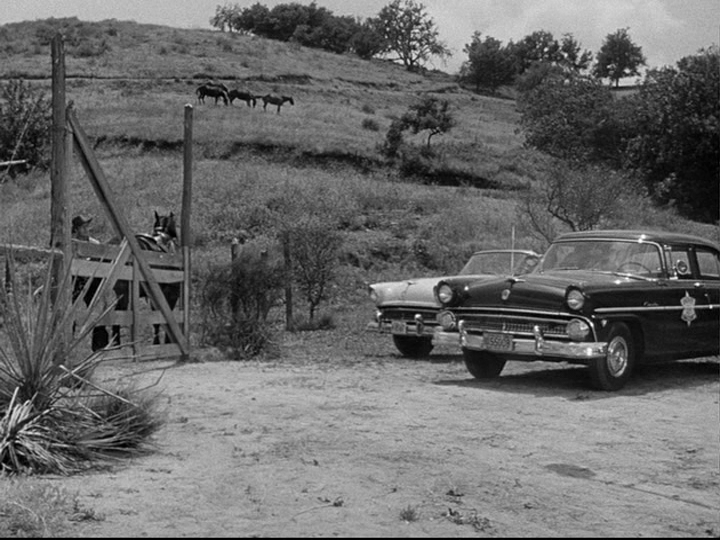
23. Cross-fade and pan right with an unfamiliar man on a horse riding across an unfamiliar landscape. The end of the shot reveals the shite convertible and a cop car. Doc came here to meet Sheriff. This must be Andy’s place like they discussed on the phone.
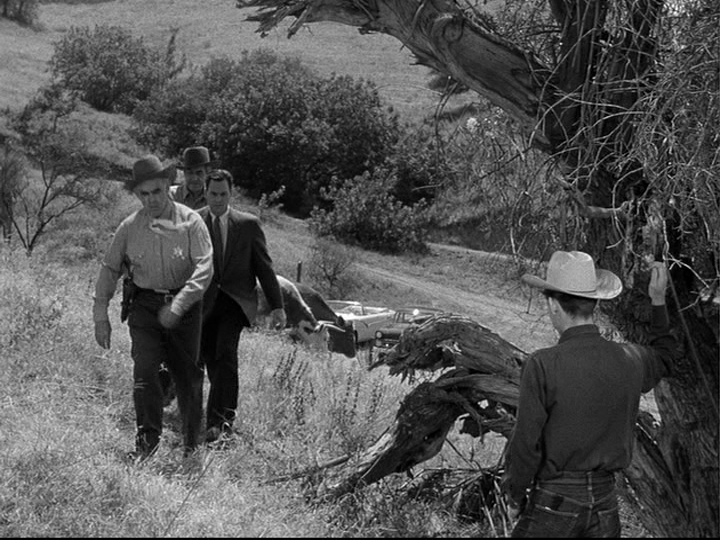
23a. I thought this was a new location because I did not see the cars behind the cows, but the characters are still in sight of the parking lot.
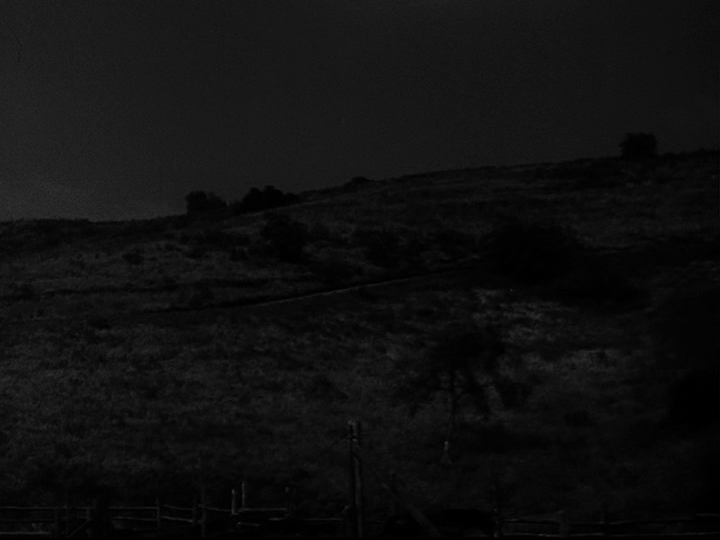
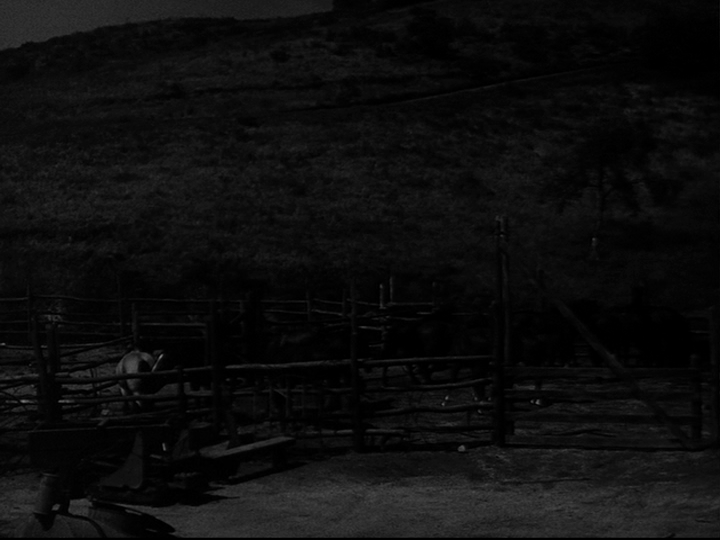
24. Cross-fade and pan right over a grassy hill and fenced in horses. This is probably Andy’s farm because the previous scene also had fences, horses, and a grassy hill. It’s night, so time has passed.

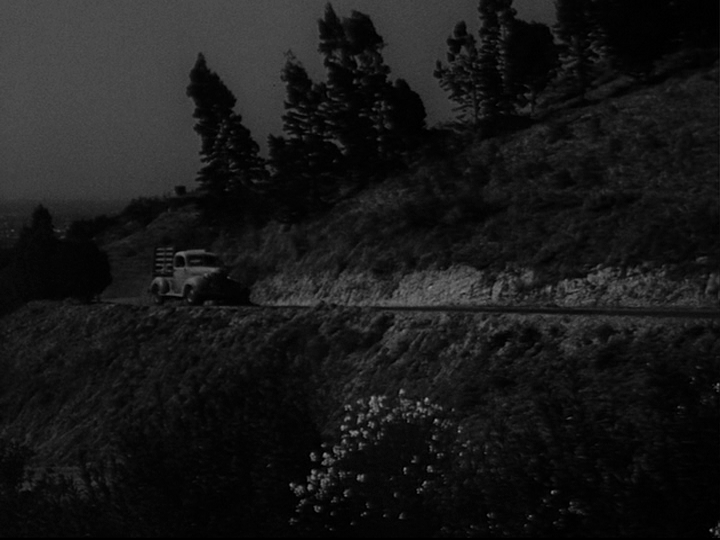

25. Cross-fade and pan right to follow a truck we’ve never seen before on a road cut through a forested hill. The next shot shows the tow men in the cab, and we’ve never seen them before. It’s still dark. People we haven’t seen before, in a new place, in a monster movie? I think these characters are going to die soon.



26. Fade to black, then fade in and pan right to follow a white car. That’s not a convertible. Who’s car is that? It’s actually not important. That car drives past three cars we know: the white convertible, the cop car, and the woodie. The three drivers appear in front of their cars: Doc, Sheriff, and Joe, the reporter. They are investigating the smashed remains of the truck from the previous scene. Night has passed and it’s daytime again.
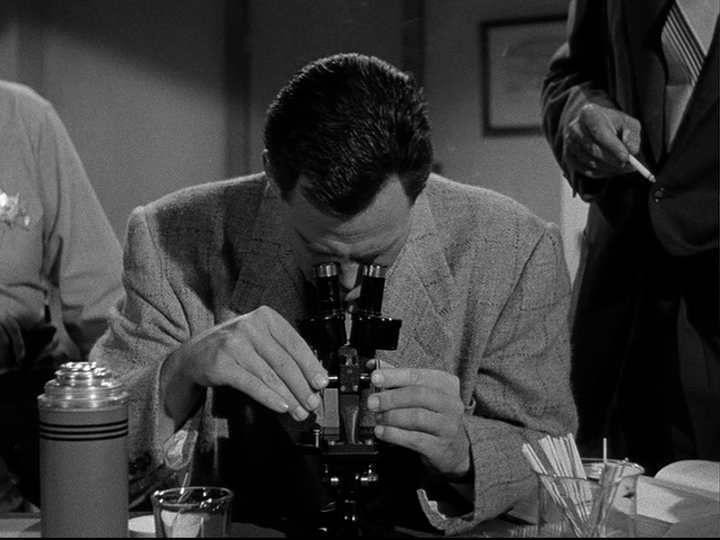
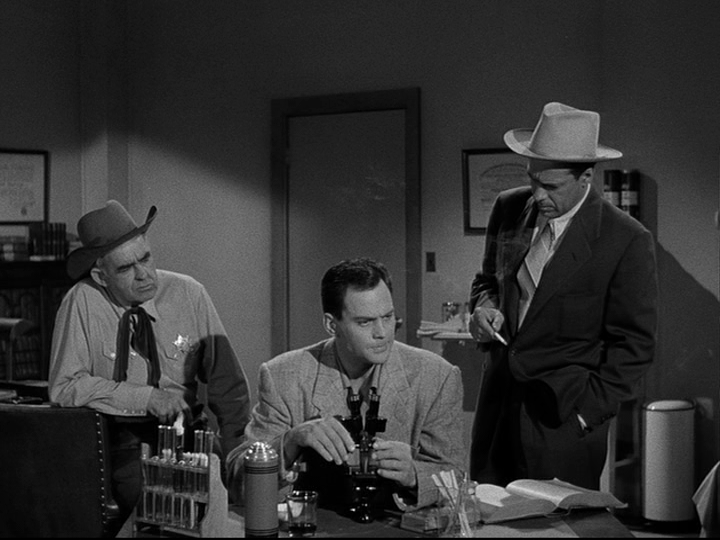
27. Cross-fade, then dolly from a microscope to Sheriff, Doc, and Jim. The room has diplomas on the wall and scientific equipment on the desk, and Doc seems to be in charge, so this is probably in Doc’s office.
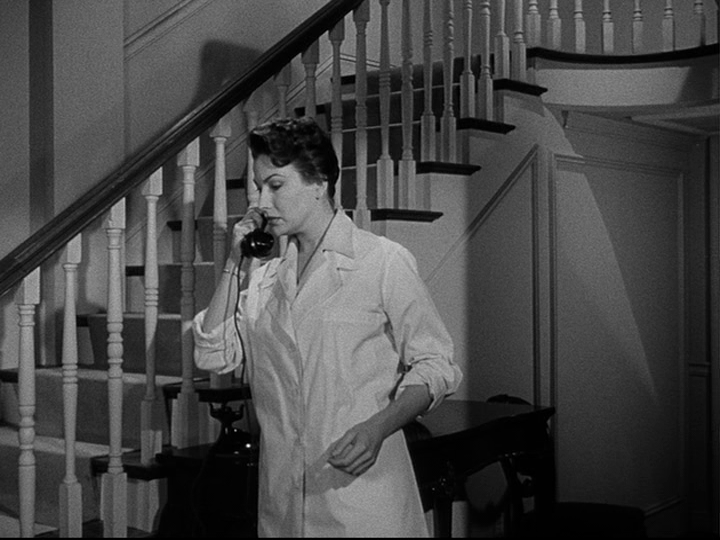
28. Cross-fade to stairs with white stair rods. Steve answers the phone. Steve lives with Deemer and Deemer’s house has stairs like that, so we’re at Deemer’s house.
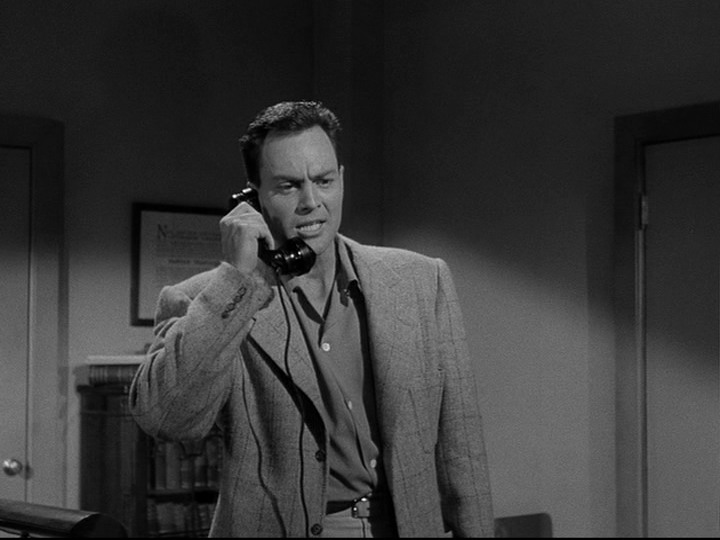
29. Cut to Doc in the same place we saw him last, so still in his office.
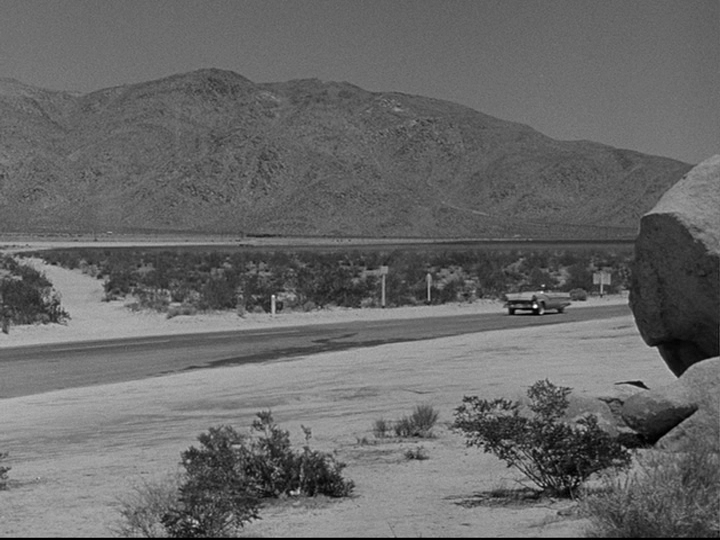
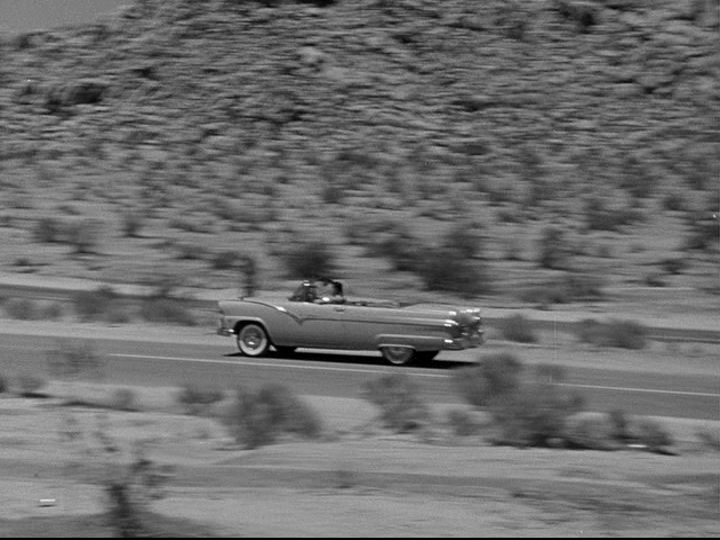
30. Cross-fade and pan left with the white convertible. Doc is driving to Deemer’s place.

31. Cross-fade to the two-storey house. The white convertible arrives. Doc meets Steve at Deemer’s house.

32. Cross-fade to a small airplane landing on a desert airstrip. Doc flies the only airplane seen so far, but last we saw that plane was in Desert Rock with him, so where is it now?

33. Cross-fade to a sign reading “Arizona Agricultural Institute” Doc flew to the city to consult experts at this institute.
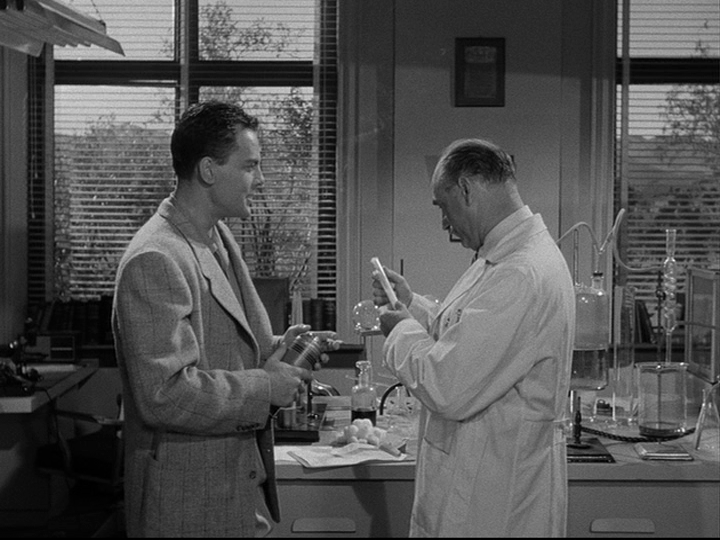
34 Cross-fade and pan left as an unfamiliar man walks into a room with scientific equipment and talks to Doc. This must be the scientific expert Doc wanted to consult.
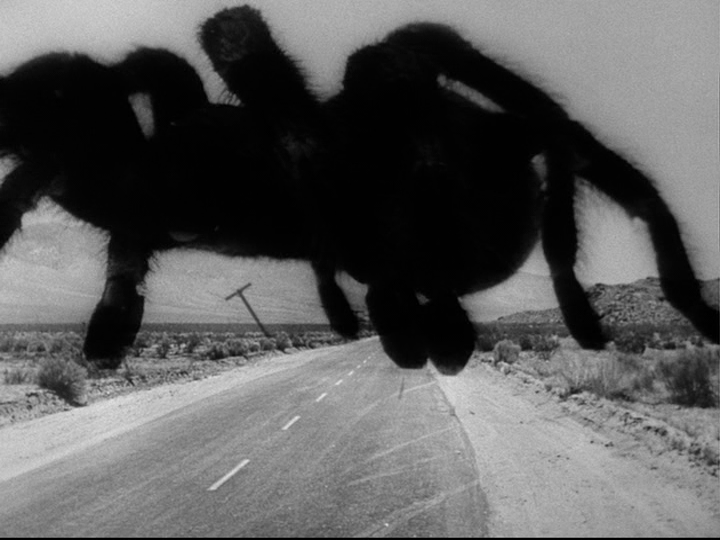
35. Cut to the Tarantula walking left and knocking over a telephone pole.

36. Cross-fade to Doc and the expert talking to a secretary (the only other woman in the movie) about the phones not working.
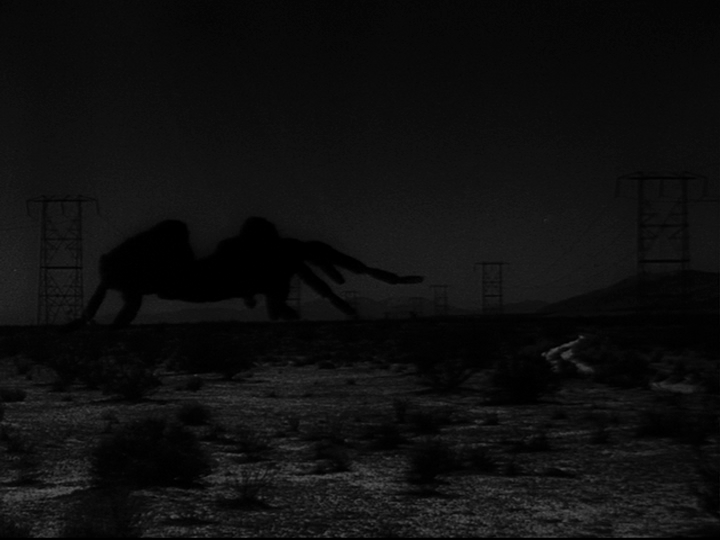
37. Cross-fade to the Tarantula moving right towards power lines. Night has fallen.

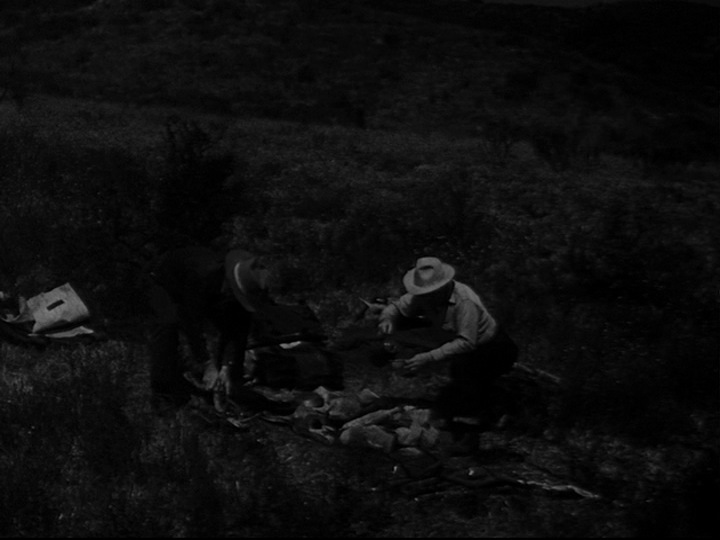
38. Cross-fade to an unfamiliar man gathering wood. Pan right as he returns to a camp with another unfamiliar man. Another pair of unknown men alone at night in a monster movie? I think they will die soon.
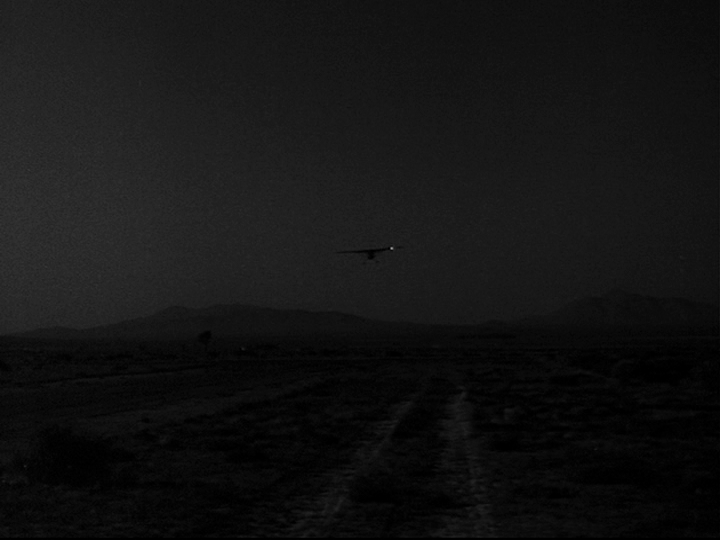
39. Cross-fade and pan left with a small airplane landing. Doc must be returning to Desert Rock Airport.

40. Cross-fade to Doc in an unfamiliar room. Immediately he says, “I’m at the airport” into the telephone. Clearly he’s using the phone at the airport.
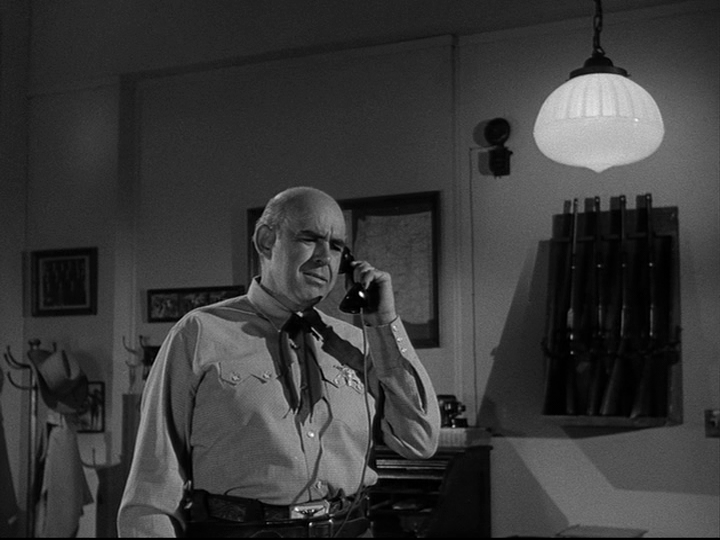
41. Cut to Jim in the Sheriff’s Office. He must be on the other end of the phone conversation with Doc.
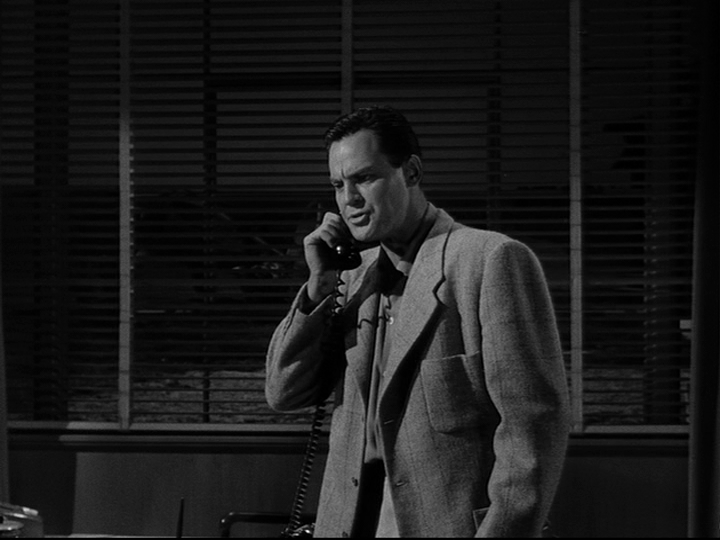
42. Cut to Doc in the same room, continuing the conversation.

43. Cut to Sheriff, continuing the conversation.
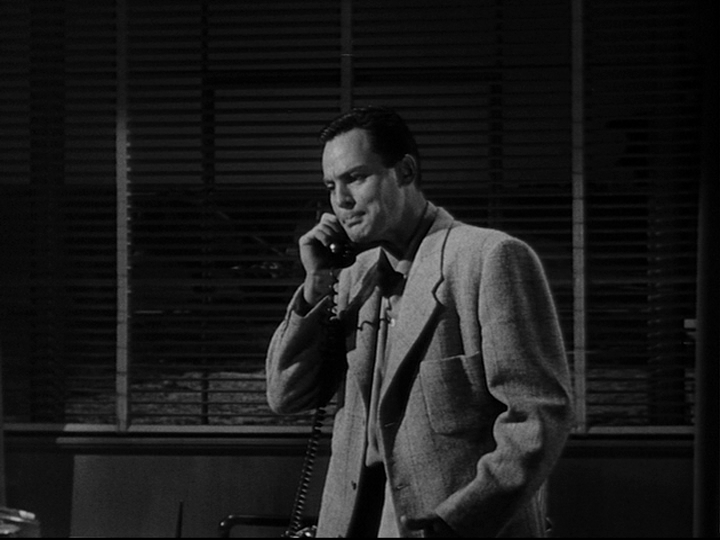
44. Cut to Doc, continuing the conversation.
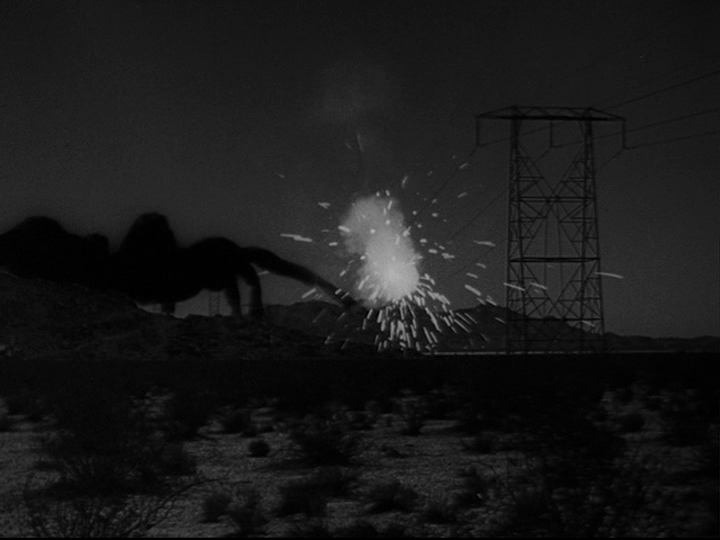
45. Cross-fade to the Tarantula, moving right and running into power lines.
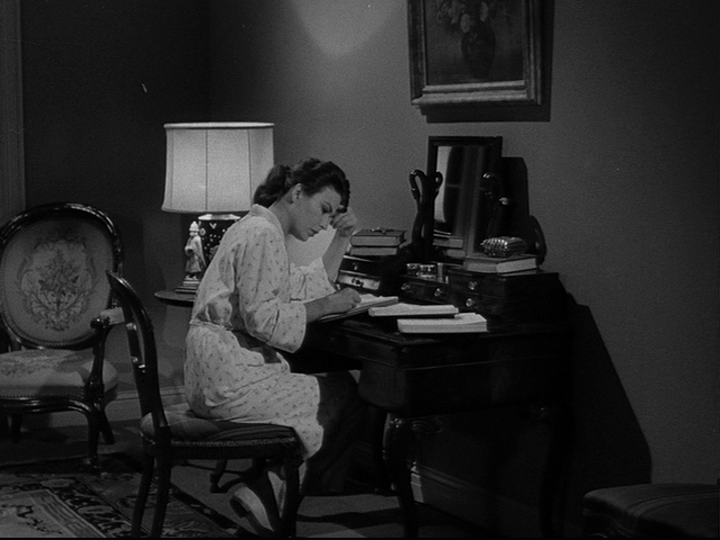

46. Cut to Steve in an unfamiliar room. She’s wearing a nightgown, so she’s probably in her bedroom. She lives at Deemer’s place. The power flickers, so the Tarantula must have hit the power lines that supply Deemer’s house.
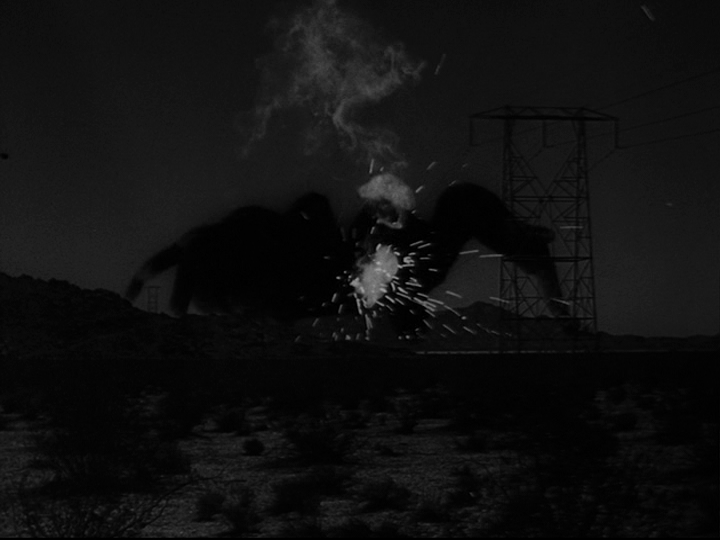
47. Cut to the tarantula moving right past the power lines.
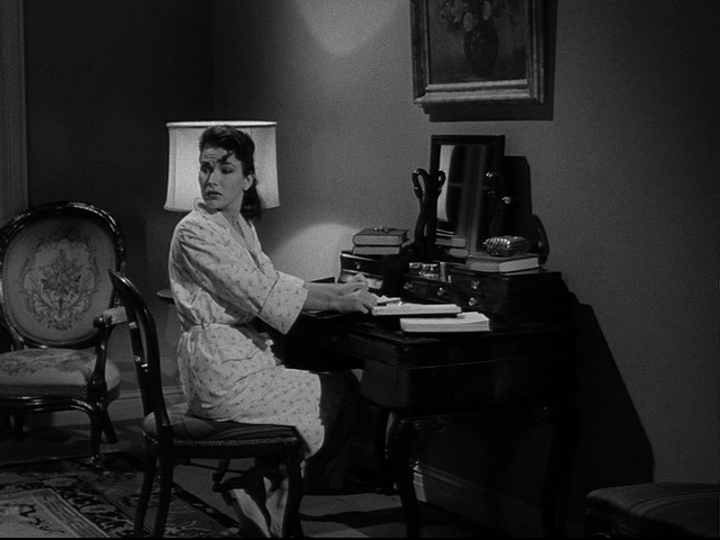
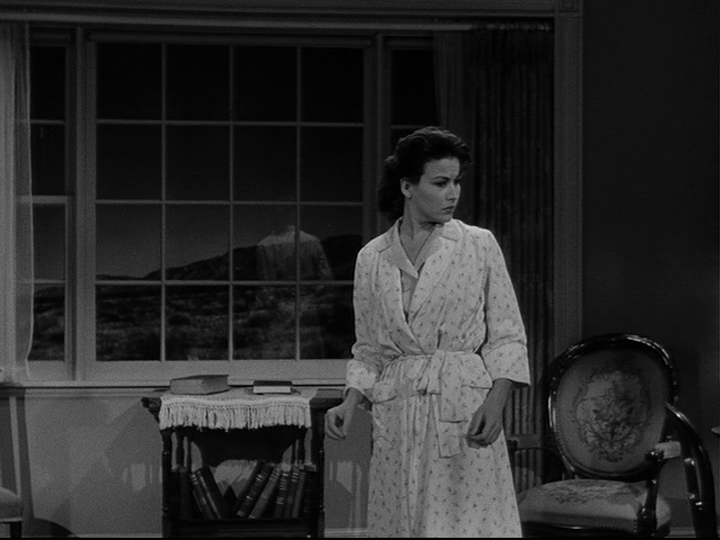
48. Cut to Steve looking left and moving left to investigate the disturbance, and revealing a large window in her room.
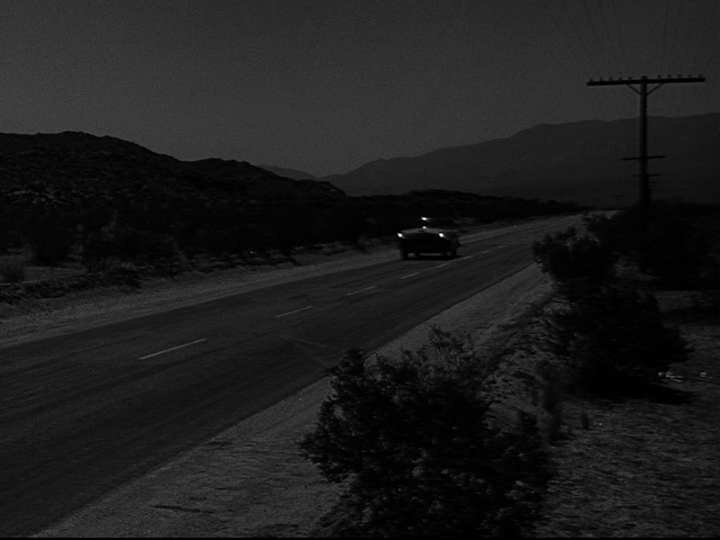
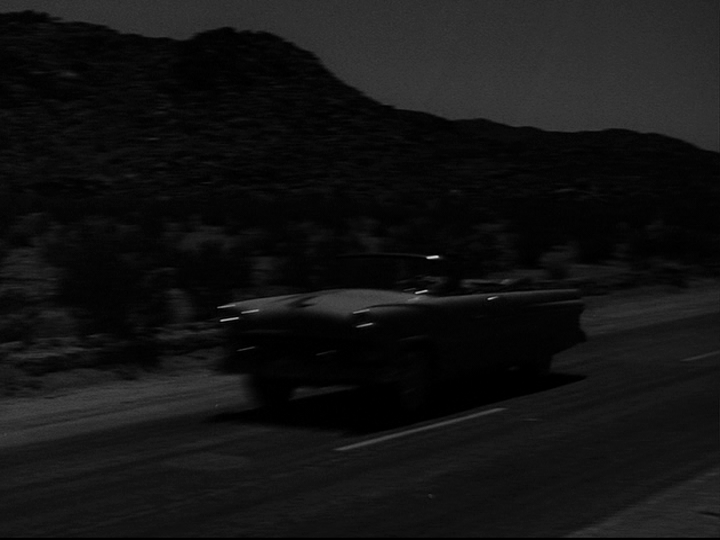
49. Cut and pan left with the white convertible. Doc is driving to Deemer’s house.

50. Cut to the Tarantula moving right towards the two-storey house. The Tarantula is almost upon Deemer’s house and Steve inside!
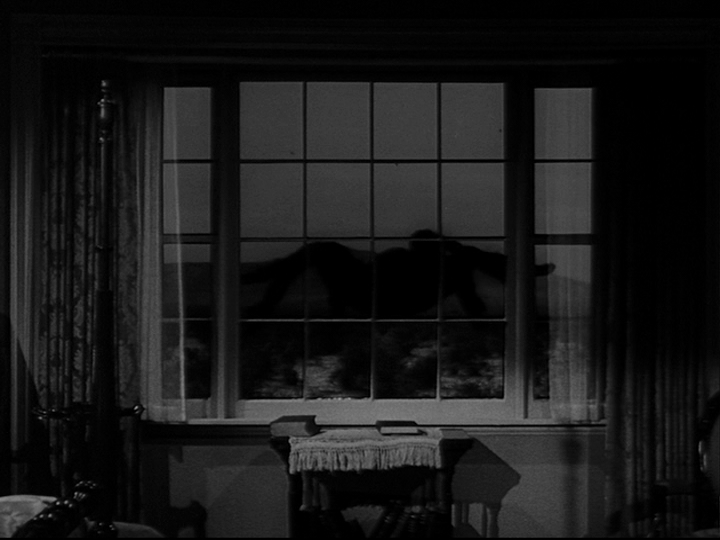
50a. To make very clear that the Tarantula and Steve are in the same place, this shot shows the Tarantula outside the window in Steve’s bedroom. Now that Steve and the Tarantula are in the same place, cutting between them doesn’t count as moving in time or space, so there are no more establishing shots.

51. Cut to the white convertible driving down and skiding to a stop in an unfamiliar location. Disorienting.
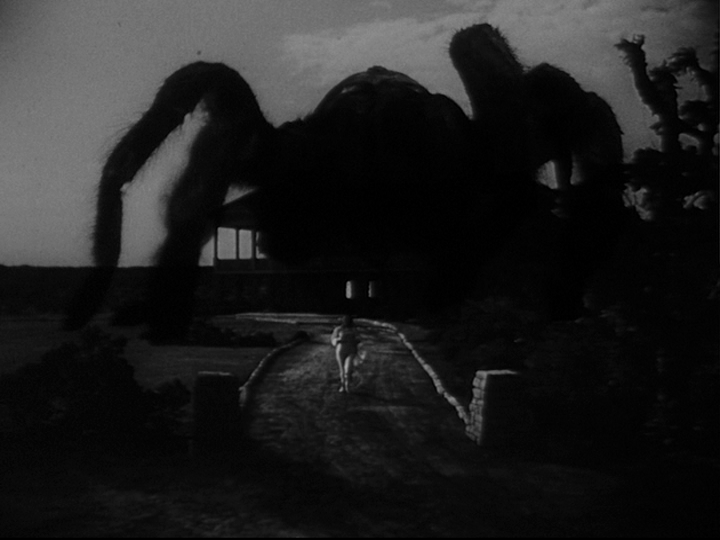
51a. This next shot, showing the Tarantula, Deemer’s house, and Steve, has the same brick pillar as the previous shot, so that must be a reverse angle. Doc has arrived at Deemer’s house, and Steve is fleeing from the Tarantula to Doc.
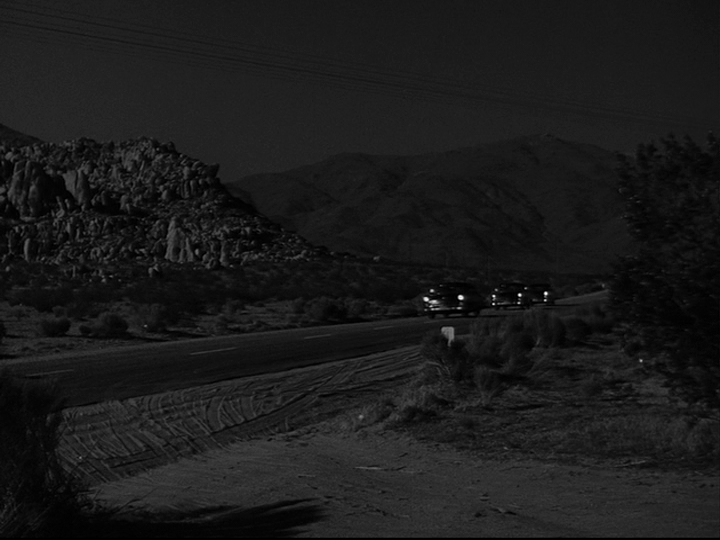
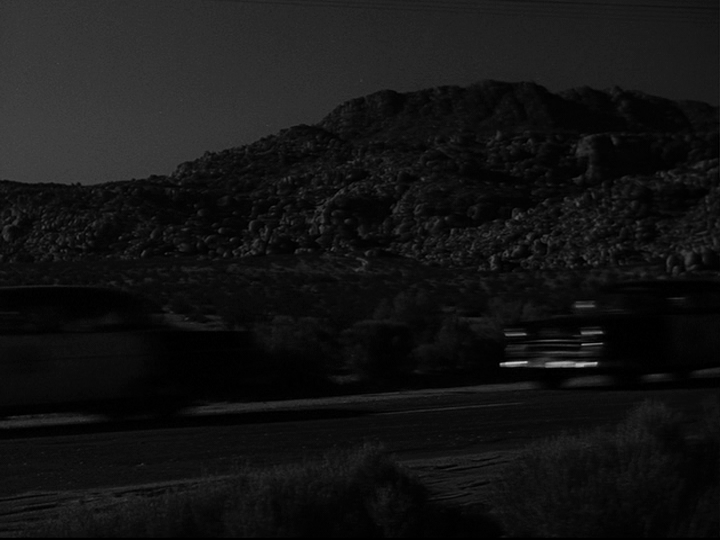
52. Cut and pan left to follow three cop cars. The police are headed towards Deemer’s house.

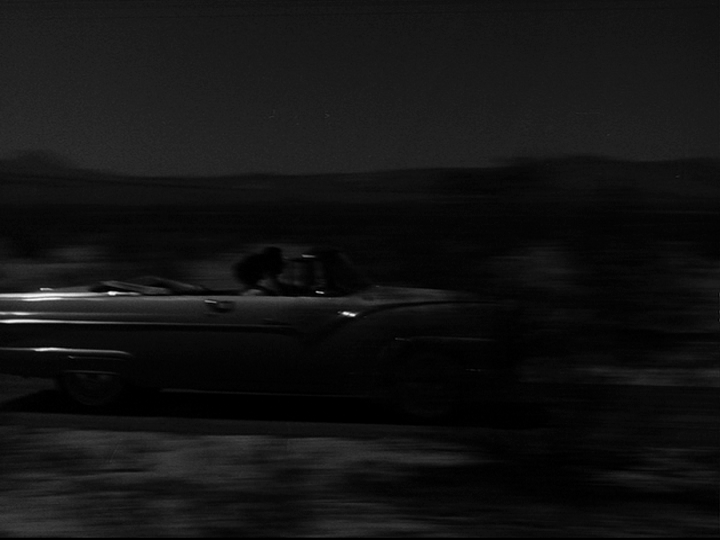
53. Cut and pan right to follow the white convertible. Doc and Steve are fleeing from the Tarantula at Deemer’s house.
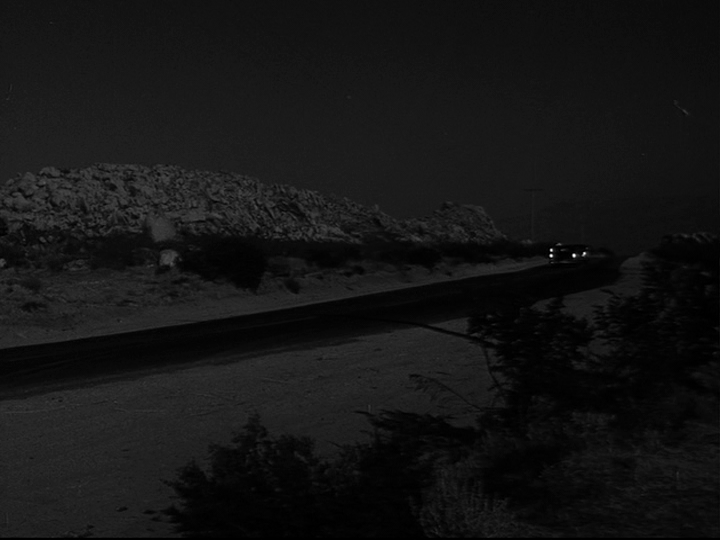

54. Cut and pan left to follow three cop cars. The mountains in the background are different from the previous time we saw the cop cars. The police continue to drive towards Deemer’s house.
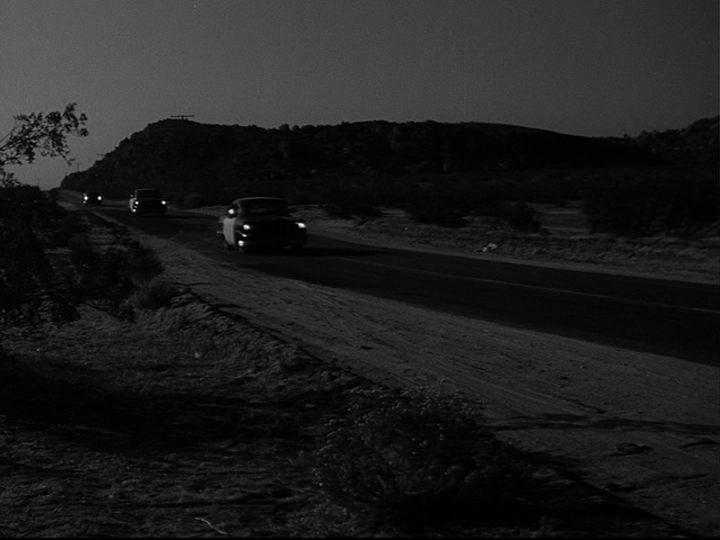
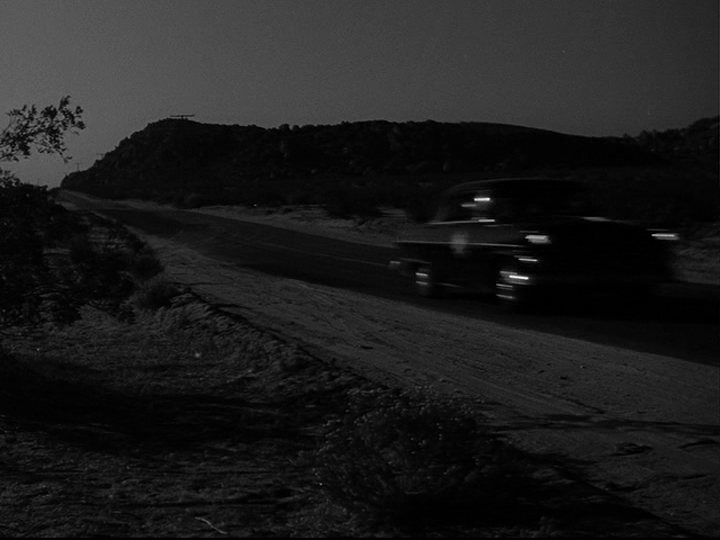
55. Cut to three cop cars driving right. The police are returning to Desert Rock.
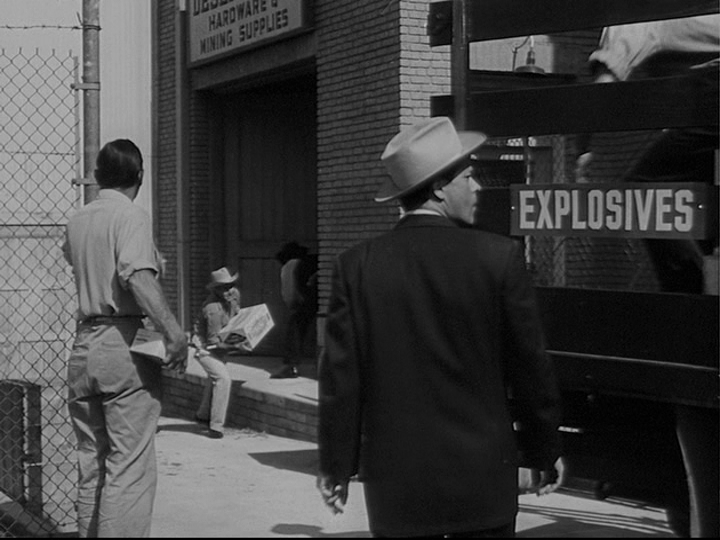
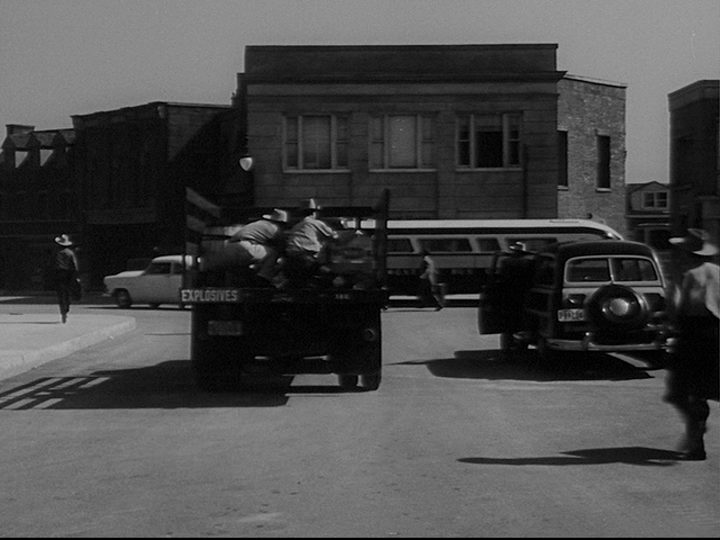
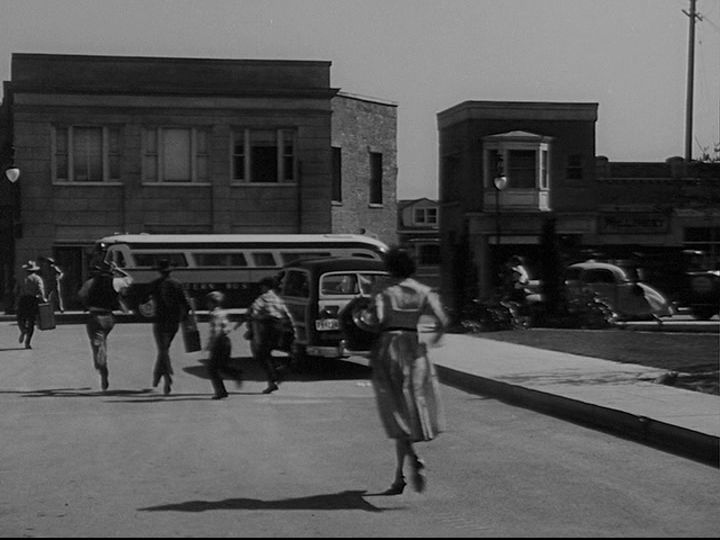
56. Cross-fade to some men in daylight. The night has passed. The men move boxes from a building labeled “Hardware Mining Supplies” to a flatbed truck labeled “Explosives” This truck will carry the explosives that Doc wants to use to destroy the Tarantula. The truck moves out and the camera pans right to follow it. Families run towards a bus carrying bags. The town is being evacuated.
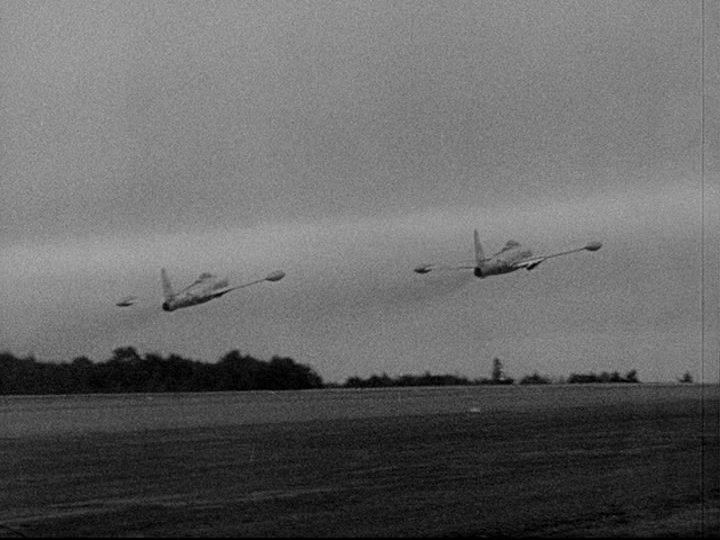
57. Cross-fade to military jets taking off. The military is responding to Desert Rock’s emergency.


58. Cut and pan right the flatbed truck and the woodie driving down desert roads. The explosives are on the way to intercept the Tarantula, and Joe the reporter is coming along.
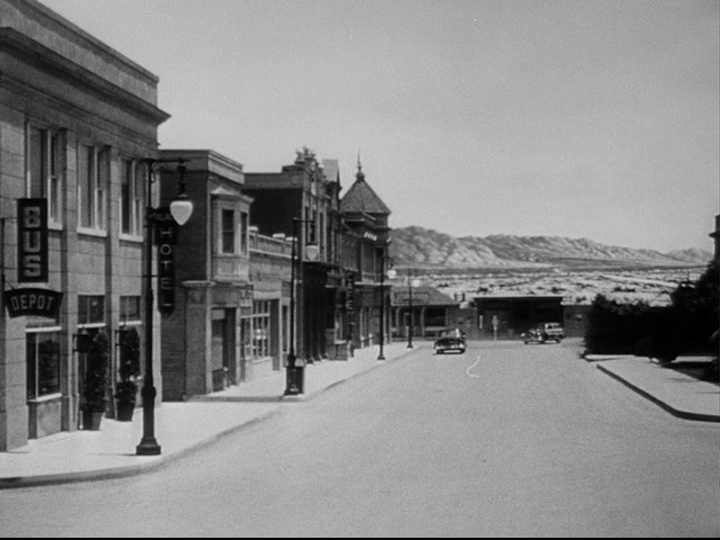

59. Cross-fade to Desert Rock (signs for the bus stop and Palace Hotel are visible) as four cars and the flatbed truck arrive. I can’t see all the cars clearly, but I’m sure it’s the three cop cars and Joe’s woodie.

Patterns
Transitions represent time
- a cut (no transition) connects two shots with no time in between. Usually used for shots in the same scene. Used a few times to intercut between simultaneous actions in two different places, like a telephone conversation.
- Scenes 44 to 52 are all connected with cuts, so the action is non-stop from the time the tarantula approaches Deemer’s house to Doc, Steve, and the surviving cops running back towards Desert Rock to set an ambush for the Tarantula.
- A cross-fade connects two shots with a short time in between.
- Most scene transitions use cross-fades.
- Cross-fades sometimes bridge small time-jumps in the same location, like between a car pulling up to a building and the driver opening the door to the building. The cross-fade is needed to explain why we don’t see the driver turn off the engine, get out, and walk around the car.
- Fade to black indicates that nothing happened for the rest of the night, and the next scene is in the morning of the next day.
- The movie contains 3 nights, but only fades to black twice. The action that starts on the third evening goes all night and into the fourth day.
Travel is vital
37/59 scenes begin with characters traveling or arriving. Most travel is by car, which makes sense for the hostile and sparsely-settled desert. In the town of Desert Rock, people walk between locations.
Panning establishing shots
22/59 scenes start by panning. Panning establishing shots mostly track vehicles, because most scenes begin with people arriving at the scene. Panning across desert vistas also emphasizes the vast open setting.
Be explicit
- Many locations are identified by signs, so the audience can read “Palace Hotel” or “B. E. Russell Funeral Parlor”
- Characters tell each other their plans, so after after Steve says she needs a ride to Deemer’s place and Doc says he can take her, the next scene is the two of them driving in a car. The audience can safely assume they are driving to the Deemer place!
- When Doc appears in a room we’ve never seen before, he immediately says, “I’m at the airport.” so there’s no confusion
Surprises
Vehicles are characters
Distinctive character design helps the audience quickly recognize characters even from afar. Sheriff is heavy and wears that hat. Deemer wears a white lab coat. Steve is a woman. Character design isn’t limited to face, body, and clothes. The vehicles that characters use in Tarantula are vital to quickly identifying who is in each scene. Cars are big, so they are visible from far away, and they are used often when characters need to travel long distances in hostile desert terrain.
- 27/59 scenes begin with vehicles
- 32/59 if you count the Tarantula as a vehicle
- Doc: small airplane & white convertible
- Deemer: black sedan
- Sheriff: Cop car
- Joe the reporter; Woodie
- Body count padders: pickup truck
- Explosives experts: flatbed truck
- Military: jets
Dialog is vital
This article is about establishing shots. That’s visual and camera-centric, but movies are audio as well as video. A location can be established by dialog, or recognized by a certain background noise.
In Tarantula, characters often tell each other where they are going, so the next scene starts with those characters arriving somewhere, the audience already knows where they are.Because I was so focused on the camerawork, I did not record all the times that characters identified places and characters in dialog. It was often!
Analyze movies as a whole. Even if you want to focus on a particular element, you can’t ignore the other parts.
Don’t underestimate anything
I thought this was a cheap, trashy movie and didn’t expect any particular craft or flair, but I was wrong!
The tarantula is quite good! It leaves a shadow on the ground. The shadow matches up with where the legs touch. There aren’t big obvious matte lines like I would expect in the 1950s. The tarantula interacts with terrain, like climbing over a hill or knocking over a telephone pole.
The camerawork has a distinct style. Each transition has a specific meaning. Scenes are introduced in consistent ways, with a few exceptions that seem deliberate. The two scenes that begin with close-ups are the two scenes that begin with people concentrating on scientific research.
Pay close attention to art and it will reward you! Especially art as complex as a movie, which requires dozens or hundreds of artists making individual contributions and working in teams. There’s a lot to see and learn from even the most humble artwork if you put in the time.